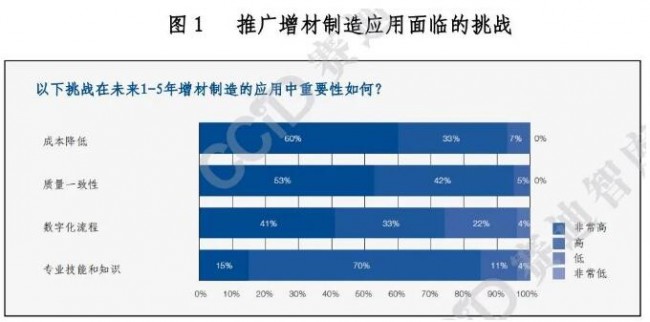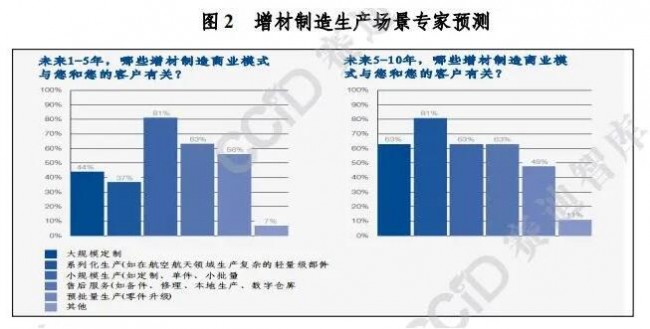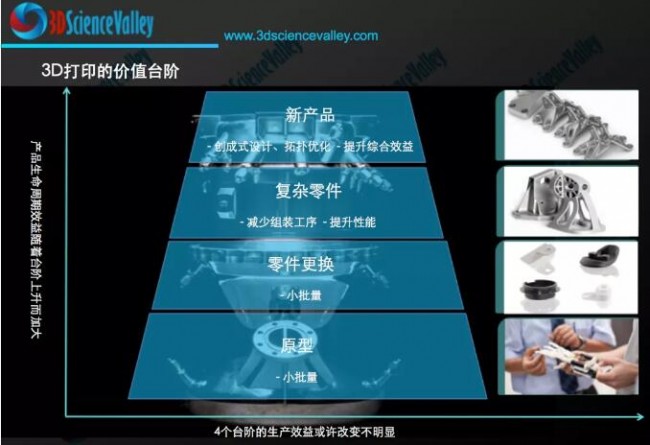In January 2022, the World Economic Forum, together with ETH Zurich and the Fraunhofer Society, released a white paper titled “Major Breakthroughs in Additive Manufacturing: How to Guide Scale and Overcome Key Challenges” (hereinafter referred to as the “White Paper”). The white paper analyzes the challenges and opportunities facing the additive manufacturing industry, future prospects and solutions, and proposes a call to action.
The Industrial Policy Research Institute of CCID Research Institute (Advanced Manufacturing Research Center) believes that my country’s additive manufacturing industry has entered a new stage of promotion and application after years of development. The large-scale application strategy proposed in the white paper is of great importance to the development of additive manufacturing in my country. Inspiration and reference.
The innovative application of additive manufacturing faces challenges such as cost, standards, digital processes, professional skills and knowledge, among which cost is the biggest challenge at this stage. In the survey analysis, 60% of the surveyed companies believe that cost reduction is the most important challenge for the innovative application of additive manufacturing in the next 1-5 years, including not only equipment and material costs, but also the high complexity of products and the combination of stability and stability. Hidden costs of lack of reliability. In addition, additive manufacturing lacks perfect standards and certification systems, and there are still shortcomings in product quality consistency, which has also become an important factor affecting the expansion of additive manufacturing applications. The digital process requires the digitalization of the entire additive manufacturing production process and supply chain based on the shared flow of digital elements; a smooth digital process is an important driving factor for additive manufacturing applications. In addition, the innovative application of additive manufacturing also requires interdisciplinary professional skills and knowledge such as machinery, software and materials, and requires a professional talent team to implement it.
 Data source: Fraunhofer surveys and interviews
Data source: Fraunhofer surveys and interviews
Additive manufacturing brings new application opportunities through new material research and development, digitization of manufacturing processes, and flexible supply chains. Based on a comprehensive analysis of industry cases, the white paper proposes three directions in which additive manufacturing has great application potential. One is to reduce manufacturing costs, improve product performance and open up new application spaces by developing new materials specifically for additive manufacturing. The second is to improve customer experience and optimize product performance through the digitization and automation of additive manufacturing processes.
 Automated Design of AM Additive Manufacturing Orthotics.
Automated Design of AM Additive Manufacturing Orthotics.
© Trinkle and Aqtor
For example, Trinckle and Aqtor! have developed an automated 3D orthotic design platform that can3D scanningAutomatically fit additively manufactured orthoses, and in the future, smart sensors can also be integrated into additively manufactured orthoses to collect data in real time when the product is in use. The third is to create a flexible supply chain through additive manufacturing to provide customers with quick response solutions. When traditional manufacturing is unable to deliver on time under the new crown epidemic, additive manufacturing can complete the delivery through a more resilient and flexible supply chain.
The main business model of additive manufacturing is still small-scale production, and its mass customization and serial production are expected to be widely used in the future. Currently, additive manufacturing is being used in small-scale production and generating considerable value in the consumer sector and in industries such as aerospace, high-end automotive, medical, and rail.
The white paper survey shows that in the next 1-5 years, small-scale customized production will be the most important business model of additive manufacturing; There may be breakthroughs in customization and mass production. The white paper proposes that in order to achieve large-scale application of additive manufacturing, it is necessary to gradually deploy the industrial ecology of additive manufacturing applications; focus on the effective needs of users and provide new cost-effective business models; integrate resources to encourage and guide users, research institutions, and manufacturers. , service providers to carry out collaborative cooperation; encourage enterprises to formulate additive manufacturing development strategies as soon as possible, and increase investment in manpower and capital.
 Data source: Fraunhofer surveys and interviews
Data source: Fraunhofer surveys and interviews
my country’s additive manufacturing industry is still in a stage of rapid growth, and the efficiency and advantages of additive manufacturing technology are gradually being accepted by the industry, showing great practical value and broad market in aerospace, rail transit, medical equipment, molds and other fields space. The key challenges, existing opportunities, and future scenario predictions discussed in the white paper provide ideas for the development of the additive manufacturing industry in my country.
Providing solutions with both efficiency and effectiveness is the primary driving force for the large-scale application of additive manufacturing in my country. The large-scale and mass production of traditional manufacturing makes the unit product cost lower, and with the integration and innovation of information technology, it can also have the ability to customize and quickly change production. At present, the successful application of additive manufacturing technology in many industries has shown that the biggest obstacle to application promotion is no longer focusing on the feasibility of the technology, but providing enterprises with the best cost-benefit ratio and suitable business model. Therefore, understanding the pain points of the industry, oriented by customer needs, and providing them with solutions based on a reasonable return on investment should become the focus of my country’s additive manufacturing enterprises to expand the market space. At present, the cost of the application of additive manufacturing technology in my country is mainly limited by the cost of materials, equipment costs, and the cost of process and product verification.
 3D printingvalue step
3D printingvalue step
© 3D Science Valley White Paper
Digitization, materials, and standards are the key links for the large-scale application of additive manufacturing in my country at this stage. The three key links of additive manufacturing include digital processes, new materials, and standardization. The essence of additive manufacturing is digital model-based manufacturing technology. In the aerospace, medical and rail transit industries that have achieved remarkable results, additive manufacturing has been fully used in R&D design, process production and performance testing. Digital thinking greatly shortens the product life cycle. New materials suitable for additive manufacturing process technology are the key to transforming digital models into products. Breakthroughs in new materials will provide users with more economical solutions and bring new business opportunities to the development of the industry. Standardization is an important guarantee for product quality. Additive manufacturing is mostly used to manufacture high-end parts with complex structure, sophisticated technology and high value. Its performance quality determines whether it can replace the original product to achieve market value. It can be seen that in order to realize the large-scale application of additive manufacturing in my country at this stage, more policy and financial attention needs to be paid to digital tools, new materials and product reliability verification.
Continuously improving the industrial ecology is a long-term inherent requirement for the large-scale application of additive manufacturing in my country. Additive manufacturing includes not only the industrial chain from materials, processes, software, core devices to equipment, but also the additive manufacturing industry ecosystem including testing, standards, certification, talents, etc. The construction and linking of this ecosystem is a slow process. the process of. On the one hand, how to digitize the industrial manufacturing process chain and how additive manufacturing suppliers digitize engineering experience, the digital interconnection between industrial manufacturers and additive manufacturing suppliers is slow; Standards and certifications for safe and continuous large-scale production capacity, and improving market recognition, are not achieved overnight. Therefore, in order to promote the industrial application of additive manufacturing in my country in all walks of life, all parties must work together to improve the feasibility of extensive application of additive manufacturing, guided by market demand and standardization.
At present, in order to achieve large-scale application of additive manufacturing in my country, it is necessary to focus on the research and development of key materials, improve process digitization capabilities, provide more cost-effective solutions, and accelerate the improvement of additive manufacturing testing, standards, certification, talents and other industrial ecological environments.
Increase capital investment in key areas of the additive manufacturing industry chain. The first is to give full play to the guiding role of the government. In key areas such as material research and development, software development, and basic databases that are difficult to obtain in the short term, relying on universities, scientific research institutes and key enterprises, increase financial support and establish a collaborative mechanism for production, education, research and application. Focus on digital software and special materials for additive manufacturing, and enhance the innovation capability of key links in the industrial chain. The second is to guide the ecological partners of the industrial chain to invest funds, and invest funds and resources in the links that can reduce costs and achieve large-scale production. Enterprises, scientific research institutions, manufacturers and service providers are encouraged to cooperate to jointly improve the digitization of the additive manufacturing industry chain and promote the open sharing of standardized interfaces, data formats and process knowledge.
Select key areas and accelerate the improvement of additive manufacturing standards and certification systems. Additive manufacturing has a wide range of applications, and the standards and testing and certification processes are relatively long, which will profoundly affect the promotion and application process of additive manufacturing. First, the American additive manufacturing standard almost covers raw material powder,3D printingIn the whole industry chain such as process and post-processing, the number of relevant standards in my country is relatively small, and the links in the industry chain are missing. It is urgent to sort out the difficulties and pain points of the industry, so that more additive companies can play the role of standard “leaders” and carry out the whole industry chain of key industries. Standard development, testing and certification. The second is to support the cooperation of additive manufacturing suppliers, users, research institutions, bidding committees and regulatory agencies, summarize experience and successful cases, and promote solutions for standard development and certification processes to a wider range of industries and industrial chain links.
Develop a continuous and long-term talent training system. The disruptive innovation of additive manufacturing to the industry requires talents to complete the transfer of knowledge, and the long-term return on investment in talents will be far greater than the benefit of short-term equipment investment. my country’s additive manufacturing talent training system is relatively weak. There are few colleges and vocational colleges specializing in additive manufacturing-related majors and disciplines, and the short-term training capabilities of enterprises are limited, resulting in a serious shortage of additive manufacturing talents in my country, which will affect the future. Important constraints on industrial growth and participation in international competition. my country must speed up the establishment of additive manufacturing disciplines in higher education and vocational education, add more additive manufacturing-related laboratories, and increase investment in additive manufacturing-related scientific research projects to reserve more for the field of additive manufacturing. Professional technology and scientific research compound talents.
(responsible editor: admin)


0 Comments for “Implications and Recommendations from the White Paper “A Breakthrough in Additive Manufacturing: How to Lead to Scale and Overcome Key Challenges””